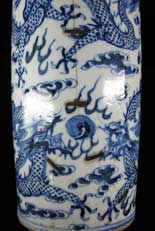Greetings,
A lot of clients ask us whether they can use the restored items for practical purposes, i.e. to drink or eat out of. We explain to them that any professional restoration precludes washing the restored items or filling them with liquid. What we mean by “professional restoration” is invisible restoration, which is what pretty much all of the clients want. However, there’s an old method of restoration called “riveting”, which does not involve gluing and bonding, airbrushing and glazing. It’s a rather crude way of restoring but it’s useful if one wants to use the restored item. See below:
In china repair the term riveting is applied to all forms of metal appliances that don’t use any adhesives and that keep broken china pieces together. Two holes are drilled for the rivet legs through china on each side of the crack or break. Those holes do not go through china but they’re deep enough for the rivets to sits firmly.
Rivets are very visible, naturally; but that’s besides the point for those who are not interested in displaying their items and want to use them instead. Rivets have certain advantages over adhesives. They provide additional support and strength, for example. Rivets also prevent cracks from spreading.
Having said all that, however, rivets are so ungainly and unsightly that most people don’t want them even if the item is not meant for display. If a broken item doesn’t have a monetary or sentimental value, clients these days simply replace the damaged piece.
Luel Restoration Studio is a premier antique repair studio specializing in invisible and partial restoration. Visit our homepage:
www.luelstudio.com



Speak Your Mind